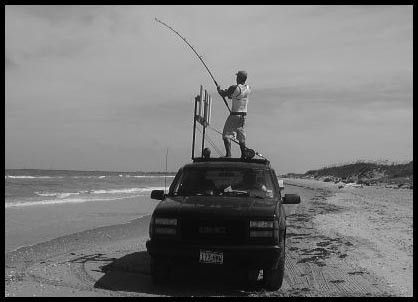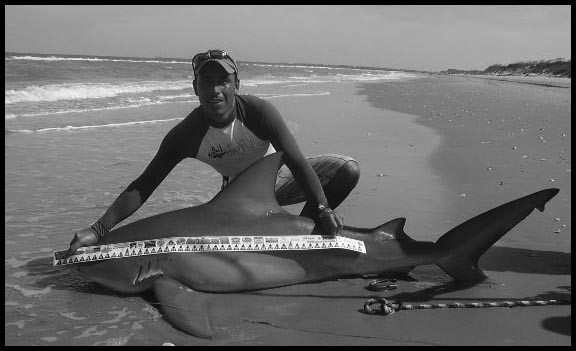Shark takes angler for a ride
Sharkathon struggle earns Corpus Christi man title
By David Sikes
Shawncy Perez of Corpus Christi caught the shark of a lifetime at
September’s Sharkathon at Padre Island National Seashore.
The 83-inch female bull shark, although not the largest shark he’s
ever taken, was enough for first place at the catch, release and photograph
event, along with $4,200 in cash, a kayak, rod and reel.
“We were on our third and last move of the trip,” Perez said. “We set
up at a hole that my friend Chris Romo and I had scouted a few weeks
earlier. We had put out a rig with a 6-inch whiting and were tying baits in
the shade when I saw one of the rods bounce twice. I jumped on the tower
on the Yukon (a fish-fighting platform built by Perez for shark angling)
and reeled in the slack.” The fight was on. “His first run was
about 150 yards,” Perez said. “Then I started to make up some ground but it
was no use, the second run was 500 yards.”
After a third run, the giant got to the back side of the sand bar, but took
off and headed south down the beach. Perez decided to make the
fighting tower mobile to get the fish in more quickly and ensure a healthy
release. “I yelled at Chris to get in the truck, and he put the Yukon in
reverse and we followed the fish down the beach.”
But the fish still had more left. “I thought the fish was about done so I
let my guard down a little,” he said. “He made one more run that about
pulled me off the tower, I had to grab the rod rack and hold on.”
Once the fish reached the beach, the fight continued. His friend Chris
Massey roped the tail of the shark and Perez tried to sit on it while the hook
was removed. “She tossed me right off the first time,” he said.
After the stainless 12/0 J-hook was easily removed, they dragged the bull
into the deep wade gut. “She took off like nothing ever happened,” Perez said.
During its brief history, the Sharkathon surf-fishing tournament
has earned a reputation as a conservation event that has improved the
image of an often-misunderstood segment of angling culture.


BATTLE ON THE BEACH:
Shawncy Perez fights his
shark on his homemade
fighting tower while Chris
Massey follows the fish
down the beach. The 83-
inch bull shark earned
Perez first place at the
Sharkathon. Photos by Chris
and Arthur Romo.
It seems to be working for this live-release contest. Before this year’s
Sharkathon in September, folks at Padre Island National Seashore,
which hosts the annual event, had nothing but praise for the contest and
its organizers. “Oh yes, we like them here,” said a
smiling PINS ranger Sharon Mason, who tended the National Seashore
entrance during Day 1 of the tournament. “They have a wonderful image,
and they’re very well respected.” Each year, Sharkathon has given
back by donating $1,000 toward a reward program that encourages park
visitors to report poaching and other rule violations within the National
Seashore.
Tournament organizers have attracted an impressive number of
Sharkathon faithful during its brief history. In its first year, the 2004 event
attracted about 50 contestants. For the 2007 contest in September, 370
anglers registered in categories that included sharks, redfish, trout and
tarpon. They also have a kids division. This concept was born on the
beach, as most might expect. During an evening about five years ago,
Sharkathon board member Pat Jordan of Eagle Lake said several
future founders sat around their Padre Island campsite after a day of surf fishing.
A conversation about dead sharks, sustainable fisheries and maintaining
their way of life evolved into a planning session for what would become a
non-profit conservation movement. They hammered out the tournament’s
framework that night. While tournament rules do not forbid
killing a fish, they expressly prohibit entering a fish that has not been successfully
released alive and swimming. And there are no live wells. If you’d like
to keep a few fillets, it’s OK. But the rules clearly state
Sharkathon is a catch, photograph and release contest. They encourage
the use of circle hooks to boost the chances of survival and anyone
caught or reported wasting game is disqualified.
Each contestant is provided an official ruler and a log sheet to record the
size and species of their catches for research purposes. Contestants are
responsible for their own digital cameras. The rules are carefully crafted to
prohibit the use of motorboats or personal watercraft either as a fishing
vessel or as a means of carrying baits. Surfboards, paddle-craft, swimming
or casting would all be acceptable means of transporting baits into the Gulf.
All fish must be caught from the beach.
Jordan said he’d like Sharkathon’s image to include this message: play
hard; kill only what you eat; pack out at least as much as you bring in; and
leave a legacy that honors the resource.
Conservation comes in many forms and can be found in some
unlikely places.
SHARKATHON RESULTS
Entries — 370 contestants
Total Awards — $18,000-plus and
about $10,000 in kayaks, rods, reels,
tackle.
Shark Division
1st — Shawncy Perez – 83 inches
2nd — Brandon Sellers – 79 inches
3rd — Chris Talbert – 67 inches
Redfish Division
1st — Dennis George — 30.5 inches
2nd — Blayne Mozisek — 30 inches
3rd — Scott Nelson — 29 inches
Trout Division
1st — J.C. Norris — 23 inches
2nd — Eric Ozolins — 22 inches
3rd — Steve Welp — 21 inches
Kids Division
1st — Dustin Hickey
2nd — Edward Davidson
3rd — Jacob Renck